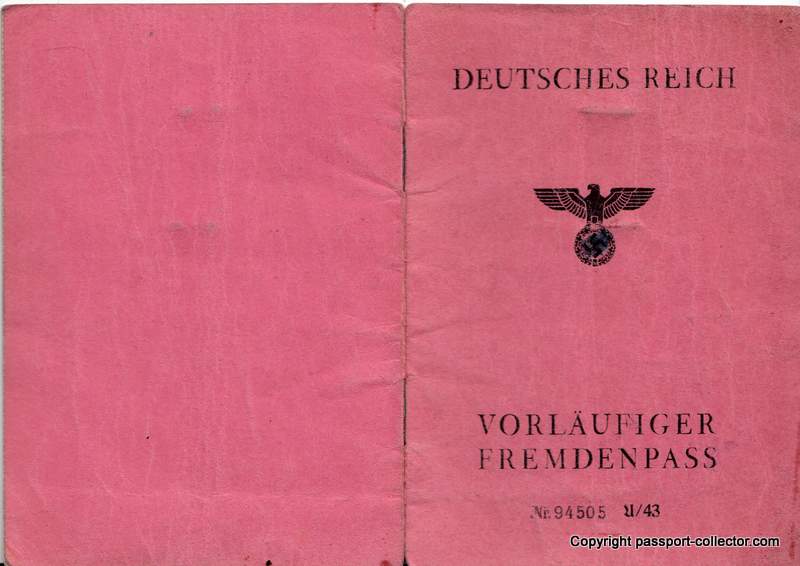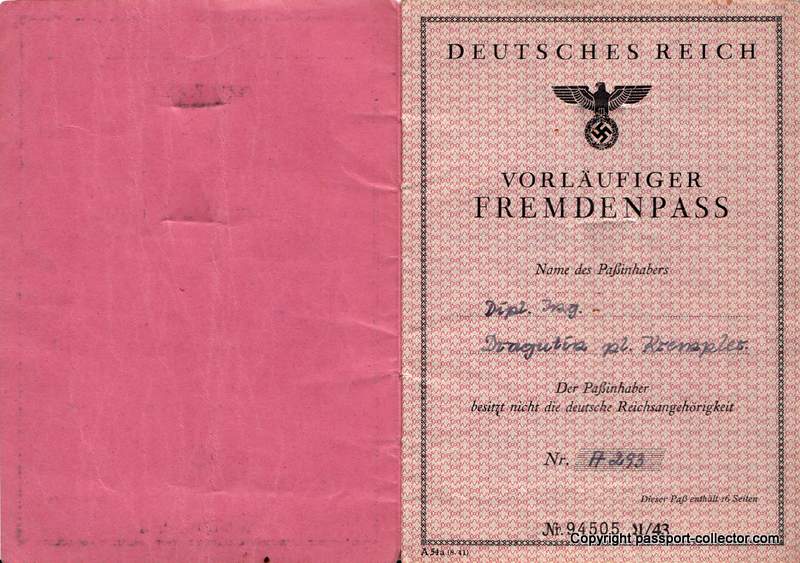SS Officer Passport – Karl von Krempler
Passport Karl von Krempler
Karl von Krempler was SS Standartenführer and SS-und Polizeiführer during World War II responsible for recruiting Muslims from Bosnia and the Sanjak region into the Waffen SS. Passport Karl von Krempler
Karl von Krempler was born on 26 May 1896 in Pirot, Kingdom of Serbia. He was the son of an Austrian engineer. In 1915 he volunteered as a cadet for the Lower Austrian Infantry Regiment No. 84 (k.u.k. Niederösterreichischen Infanterie-Regiment Nr. 84). In 1920 he was released from active service with the rank of Lieutenant (Oberleutnant).
He spoke fluent Turkish, Serbian and German. He was considered a specialist within the SS on Islam and in 1942 was recruited by Heinrich Himmler and SS Lieutenant-General Artur Phleps to participate in the formation of a proposed Bosniak Handschar Division within the Waffen SS, the 13th Waffen Mountain Division of the SS Handschar (1st Croatian). Unlike most SS personnel, Krempler was not a member of the Nazi Party. Passport Karl von Krempler
Following his appointment to the post of Höhere SS-und Polizeiführer Sandschak (Higher SS and Police Leader Sanjak) in September 1943, von Krempler came to be known as the “Sanjak Prince” after his relatively successful formation of the Police Self-Defense Regiment Sandjak. He went to the Sanjak region in October and took over the local volunteer militia of around 5,000 anti-communist, anti-Serb Muslim men headquartered in Sjenica. This formation was sometimes thereafter called the Kampfgruppe Krempler or more derisively the “Muselmanengruppe von Krempler”. As the senior Waffen SS officer Karl von Krempler appointed a token local Muslim named Hafiz Sulejman Pačariz as the formal commander of the unit, but as the key military trainer and contact person with German arms and munitions, remained effectively in control. Passport Karl von Krempler
Krempler was replaced in June 1944 by SS Oberführer Richard Kaaserer, who commanded the Sandschak Regiment from 21 June 1944 to 28 November 1944. Kaaserer had been a member of the Austro-Hungarian Army in World War I. Unlike von Krempler, Kaaserer was extradited to Socialist Yugoslavia after the war, and was tried and executed in January 1947 for alleged war crimes. In January 1945 he was re-assigned to the administrative staff of the 13th Waffen Mountain Division of the SS Handschar (1st Croatian). Karl von Krempler escaped the Communist regime of Josip Broz Tito and died on 17 April 1972 in Salzburg, Austria. Read more in the book “Heim ins Reich – Hitlers willigste Österreicher”.
The Passport Passport Karl von Krempler
The passport is a red sixteen-pages temporary Alien passport of the Reich. It writes Dipl. Ing. Dragutin (Karl in Croatian) pl. (Von) Krempler. He didn’t have German citizenship. The document was issued at Zell am See, 26 April 1944 and has included a residence permit stamp with the same date and valid until 1947.
To find travel documents of such significant SS officers is rare.
FAQ Passport History
Passport collection, passport renewal, old passports for sale, vintage passport, emergency passport renewal, same day passport, passport application, pasaporte passeport паспорт 护照 パスポート جواز سفر पासपोर्ट
1. What are the earliest known examples of passports, and how have they evolved?
The word "passport" came up only in the mid 15th Century. Before that, such documents were safe conducts, recommendations or protection letters. On a practical aspect, the earliest passport I have seen was from the mid 16th Century. Read more...
2. Are there any notable historical figures or personalities whose passports are highly sought after by collectors?
Every collector is doing well to define his collection focus, and yes, there are collectors looking for Celebrity passports and travel documents of historical figures like Winston Churchill, Brothers Grimm, Johann Wolfgang von Goethe. Read more...
3. How did passport designs and security features change throughout different periods in history, and what impact did these changes have on forgery prevention?
"Passports" before the 18th Century had a pure functional character. Security features were, in the best case, a watermark and a wax seal. Forgery, back then, was not an issue like it is nowadays. Only from the 1980s on, security features became a thing. A state-of-the-art passport nowadays has dozens of security features - visible and invisible. Some are known only by the security document printer itself. Read more...
4. What are some of the rarest and most valuable historical passports that have ever been sold or auctioned?
Lou Gehrig, Victor Tsoi, Marilyn Monroe, James Joyce, and Albert Einstein when it comes to the most expensive ones. Read more...
5. How do diplomatic passports differ from regular passports, and what makes them significant to collectors?
Such documents were often held by officials in high ranks, like ambassadors, consuls or special envoys. Furthermore, these travel documents are often frequently traveled. Hence, they hold a tapestry of stamps or visas. Partly from unusual places.
6. Can you provide insights into the stories behind specific historical passports that offer unique insights into past travel and migration trends?
A passport tells the story of its bearer and these stories can be everything - surprising, sad, vivid. Isabella Bird and her travels (1831-1904) or Mary Kingsley, a fearless Lady explorer.
7. What role did passports play during significant historical events, such as wartime travel restrictions or international treaties?
During war, a passport could have been a matter of life or death. Especially, when we are looking into WWII and the Holocaust. And yes, during that time, passports and similar documents were often forged to escape and save lives. Example...
8. How has the emergence of digital passports and biometric identification impacted the world of passport collecting?
Current modern passports having now often a sparkling, flashy design. This has mainly two reasons. 1. Improved security and 2. Displaying a countries' heritage, icons, and important figures or achievements. I can fully understand that those modern documents are wanted, especially by younger collectors.
9. Are there any specialized collections of passports, such as those from a specific country, era, or distinguished individuals?
Yes, the University of Western Sidney Library has e.g. a passport collection of the former prime minister Hon Edward Gough Whitlam and his wife Margaret. They are all diplomatic passports and I had the pleasure to apprise them. I hold e.g. a collection of almost all types of the German Empire passports (only 2 types are still missing). Also, my East German passport collection is quite extensive with pretty rare passport types.
10. Where can passport collectors find reliable resources and reputable sellers to expand their collection and learn more about passport history?
A good start is eBay, Delcampe, flea markets, garage or estate sales. The more significant travel documents you probably find at the classic auction houses. Sometimes I also offer documents from my archive/collection. See offers... As you are already here, you surely found a great source on the topic 😉
Other great sources are: Scottish Passports, The Nansen passport, The secret lives of diplomatic couriers
11. Is vintage passport collecting legal? What are the regulations and considerations collectors should know when acquiring historical passports?
First, it's important to stress that each country has its own laws when it comes to passports. Collecting old vintage passports for historical or educational reasons is safe and legal, or at least tolerated. More details on the legal aspects are here...
Does this article spark your curiosity about passport collecting and the history of passports? With this valuable information, you have a good basis to start your own passport collection.
Question? Contact me...






